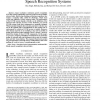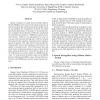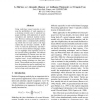36 search results - page 5 / 8 » Discriminative training of hierarchical acoustic models for ... |
NAACL
1994
13 years 8 months ago
1994
The key problem to be faced when building a HMM-based continuous speech recogniser is maintaining the balance between model complexity and available training data. For large vocab...
ISCI
2008
13 years 7 months ago
2008
Spelling speech recognition can be applied for several purposes including enhancement of speech recognition systems and implementation of name retrieval systems. This paper presen...
TASLP
2002
13 years 7 months ago
2002
Large vocabulary continuous speech recognition (LVCSR) systems traditionally represent words in terms of smaller subword units. Both during training and during recognition, they re...
ICPR
2006
IEEE
14 years 8 months ago
2006
IEEE
Speech recognition is usually based on Hidden Markov Models (HMMs), which represent the temporal dynamics of speech very efficiently, and Gaussian mixture models, which do non-opt...
EMNLP
2010
13 years 5 months ago
2010
Using multi-layer neural networks to estimate the probabilities of word sequences is a promising research area in statistical language modeling, with applications in speech recogn...



